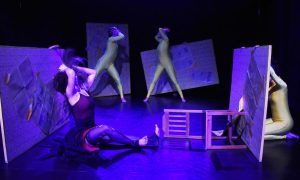It’s winter, and that means (apart from those us of who live where it stays beautifully warm) cold weather. That doesn’t mean our busy dancing and cross-training schedules stop, however. Working cold muscles can lead to sprains, strains and extra soreness. You might also generally feel tighter and less able to fully explore your body’s “bendy” limits.
Ways to keep your muscles warm in the studio and performance spaces include building your own short warm-up set that you can do any time (such as before going on stage or before class), dressing in layers and enjoying healthy warm treats. On the other hand, after using these strategies, respect your body’s messages about what it can and can’t do during this time of year. Flexibility is only one of many aspects of your artistry as a dancer, so perhaps take this season to build things like your core strength and composition or choreography skills.
Your Quick Warm-Up
You know how it can be trying to keep your muscles warm for rehearsal, class or performance. You dutifully do a short ballet barre a half-hour before dress rehearsal, but there’s a lighting complication – and you’re not dancing on stage for another hour-and-a-half. You warmed up to audition a solo, but you’re not “on deck” for another hour.
In cold weather, long periods in between warming up and dancing are only more likely to make your muscles “cool” down again. Sometimes you don’t have time to do your whole warm-up again. Furthermore, that could drain energy that you could put into your dancing. To get yourself warm enough to dance full out, but avoid time crunches and tiring yourself out, make a short warm-up sequence that works for you – at your present technique level and artistic preferences.
Include all the ballet barre basics – pliés, tendus, dégagés, fondues, attitude swings, as well as forward, backward and side bends. Good dance educators make warm-up class exercises that efficiently and compellingly combine these essential dance “ingredients”. If you have a few of those that you know well and love, from your favorite teachers, use them. It’s helpful to customize a sequence of exercises that you feel truly comfortable with. That way, you can focus on how your body is feeling and get into the right state of mind for dancing your best.
Dress for Success
In cold weather, it can be tough to dress in ways that you’re “bundled” for the outside, yet won’t feel overheated when you come into buildings with the heat up full-blast (especially if you’re dancing in them, too!). If you don’t stay warm enough outside, you’ll come into class/performance/rehearsal with cold muscles (read: potential for injury!). If you step outside with clothing that keeps you too warm, you could end up sweaty (and therefore more likely to get dehydrated) and maybe even experience symptoms of heat exhaustion (such as dizziness).
It can help to dress in many lighter-material layers, versus in one, two or a few layers made from warmer, thicker materials (such as wool). With more, lighter-material layers, you can leave the house equipped for the cold and shed layers if you get too warm. It can be annoying to carry around layers that you’ve taken off, but that’s better than not being dressed in a way that’s right for your body. All of that includes when you’re dancing; you can start class in a few layers to help get your muscles warmer faster, and take layers off as class continues. For all of the reasons mentioned, it’s important for dancers to keep a safe, healthy body temperature. Having many clothing options from having many layers can truly help maintain that temperature in these cold winter months.
Mmmmm……Meals to Warm Yourself From the Inside Out
Choosing warm foods and drinks can also significantly help to heat up your whole body (including your muscles) – because they can give you that feeling of being warm from the inside-out. Warm, healthy options for breakfast include oatmeal, grilled fruits, egg whites, toast, herbal teas and coffee (in moderation and with low fat dairy for a creamer). For dinner and lunch, try soups, grilled sandwiches (with vegetables, low fat dairy and lean meats), brown rice and pasta (in moderation), and sautéed vegetables.
Warm herbal teas can be enjoyed any time of the day, without the concern of losing sleep from too much caffeine – just moderate the amount of sugar that you add. Honey and agave syrup are also more natural, even more flavorful, options. Warm dessert foods, such as pies and tarts, are often full of fat and sugar. You can find healthy recipes for these, however, and make your own more nutritious versions (using more fruit and less cream, for instance).
With Tighter Muscles, Stretch Yourself in New Ways
Even with sincere and diligent efforts to keep our muscles warm in cold winter months, we dancers might feel stiffer and unable to be as expressive with our bodies as we can be in warm summer months. Muscular fluidity and flexibility are important aspects of being a skilled dancer, but not the end-all and be-all. Perhaps you can devote time and energy to building your core strength this winter, if it so happens that your battement just won’t get as high as it can during the heat of the summer.
Maybe, even with reduced flexibility and increased stiffness, your mind is in a contemplative and creative place. Then delve into developing your body of choreography and composition skills!
Use the healthy techniques mentioned above to keep your muscles as warm as possible in your winter dance work, but, in the end, try to enjoy the season for what it is.
By Kathryn Boland of Dance Informa.













